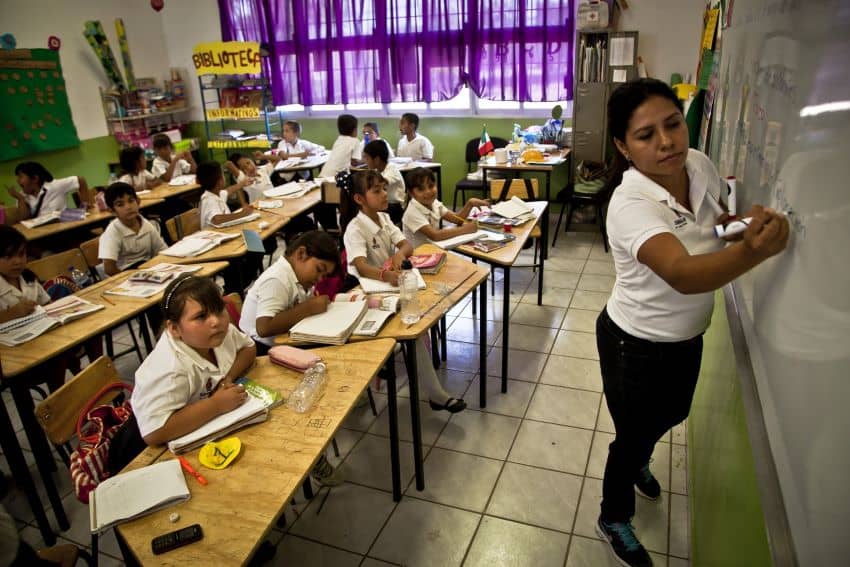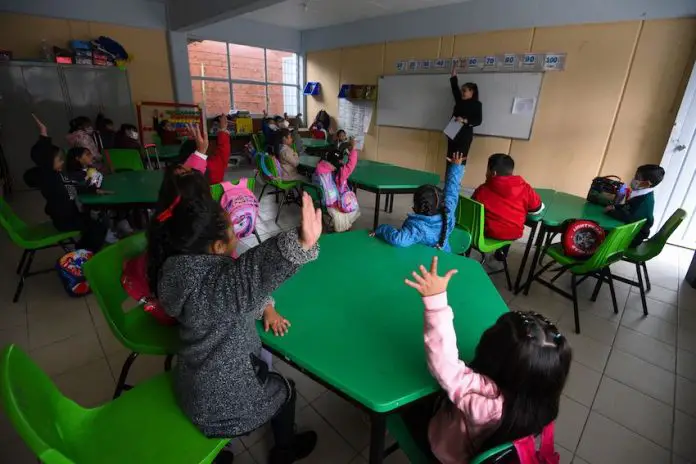In its constitution, Mexico states that every individual has the right to receive an education. But as with other human rights such as health or safety, some kind of assessment or test is necessary to know if the state effectively implements this right as required by its citizens.
In the case of Mexico, education is an area that has been neglected by many administrations, independently of the ruling party. This is aggravated by long-standing national problems including deep poverty, demographic inequality, the gender gap and insufficient education budgets. Students in Mexico consistently score among the lowest in reading literacy, mathematics and science compared to the other 37 nations in the Organization for Economic Cooperation and Development (OECD).

Regarding the government’s annual budget, in 2014, the OECD noted that Mexico’s annual expenditure per student was well below the OECD average. By 2017, economic pressures caused the Mexican government to cut their education budget even further — by more than 11%. Today, Mexico spends US $3,239 annually per full-time equivalent student, compared to the OECD average of US $12,647.
What is PISA and why does it matter?
The Program for International Student Assessment (PISA) is a valuable tool that goes beyond simply testing students. PISA provides governments with a clear picture of how well their education systems are preparing students for the future. This international benchmark allows countries to identify areas of strength and weakness, fostering collaboration and innovation in education on a global scale.
For Mexico, PISA provides a tool to assess our educational system, track performance trends and highlight the need for educational reform. After the release of the 2022 PISA results, it is evident that we have an educational crisis, exacerbated by the impact of the COVID-19 pandemic on learning outcomes.
Recommendations from the Mexican Institute for Competitiveness (IMCO) stress the need to prioritize mathematics in academic curricula, enhance resource distribution and implement standardized assessments to address educational challenges highlighted by the PISA evaluation.
In 2022, Mexico’s 15-year-olds scored an average of 410 points in science, lower than the OECD average of 485 points. In mathematics, Mexico ranked in 57th place — out of 81 countries — with 395 points and 49th in reading with 415 points, placing below the OECD and total sample averages. Furthermore, Mexico has one of the highest indexes of mathematics anxiety among OECD and partner countries, indicating challenges in this subject area.
Overall, Mexico’s performance on the PISA assessment reveals areas of improvement needed in educational outcomes and highlights disparities in performance compared to other countries, especially in mathematics and science proficiency levels.
📚El rezago educativo es un reto para la próxima administración. Las evaluaciones estandarizadas miden los aprendizajes de los estudiantes. De acuerdo con #PISA2022 de @ocdeenespanol, México🇲🇽 se coloca por debajo del promedio mundial. https://t.co/Vzos5MPHkx pic.twitter.com/2JzhCEGXfl
— IMCO (@imcomx) April 27, 2024
The PISA test in Mexico: Why we need it
For the first time in 25 years, Mexico is running the risk of not participating in the PISA assessment.
Due to administrative shortcomings, Mexico is not currently authorized to supervise this year’s test. Mexico’s Education Ministry (SEP) must act now in order to take advantage of the test’s “valuable information on the command of essential knowledge, the implementation of which will take effect next year,” as several organizations exhorted in a letter to the president published by over 100 signatories on May 21.
Although criticism of the PISA test comes in many forms, one of the most recurring arguments in Mexico is that the test does not take into account the cultural diversity or idiosyncrasy of the Mexican student, much less the national educational system that we want to build.
Like many other forms of diagnosis and evaluation, the PISA test can be perfected, and in fact, context must be taken into account to decide what to do with the results.
Still, based on the results obtained from the PISA, diagnoses can be made at the country level for the design of public policies. In the PISA 2025 test, for example, emphasis will be placed on scientific education so that there is a diagnosis of how different countries are preparing their students to understand science and the ways in which the field offers reliable knowledge. The idea is that students become informed citizens for future decisions related to their personal health, their family and how all of this relates to the environment and the well-being of the communities where they live. There is also a section of the 2025 test that invites students to show their knowledge of varied perspectives and solutions for the different socio-ecological crises they may face in the future.
The bottom line? PISA, through evaluation and assessment, helps to improve the full exercise of Mexican students’ right to education, in terms of evaluating where we need to invest more resources to improve classroom outcomes.
Patricia Illoldi-Rangel holds a Ph.D. in Biological Sciences from the National Autonomous University of Mexico (UNAM) and a Master’s degree in Education from the Monterrey Institute of Technology and Higher Education.
In addition to her research work, Patricia has been actively involved in teaching at various levels. She has served as a professor at the high school, undergraduate, and graduate levels in both public and private institutions. Specifically, she has taught courses related to STEM subjects, sustainable development, environmental education and educational innovation.
